Laid down October 4, 1989 Launched 1993 Weight 26,250 tons Draft 11 m | Operator Atomflot (Rosatom) Yard number 705 Construction started 4 October 1989 Length 160 m Displacement 23.44 million kg | |
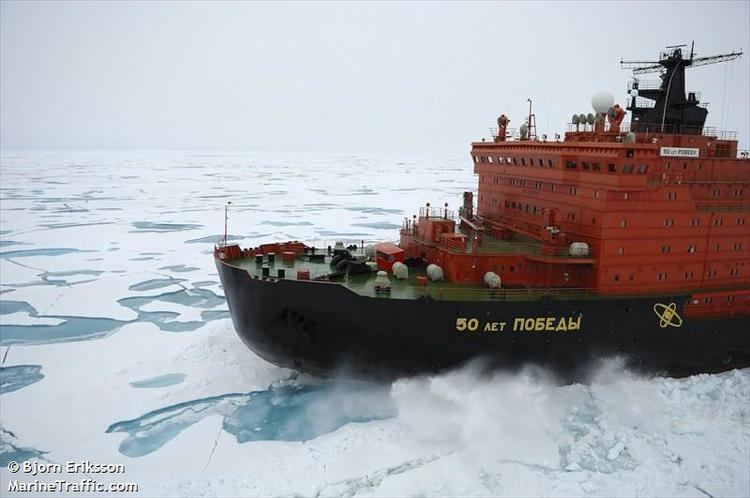 | ||
Name 50 Let Pobedy (50 лет Победы) Builders | ||
Russian nuclear powered ice breaker ship 50 let pobedy
NS 50 Let Pobedy (Russian: 50 лет Победы), translated as 50 Years of Victory or Fiftieth Anniversary of Victory (referring to victory in the Second World War), is a Russian Arktika-class nuclear-powered icebreaker. She was the world's largest nuclear-powered icebreaker until surpassed by the LK-60Ya-class Arktika (launched 2016).
Contents
- Russian nuclear powered ice breaker ship 50 let pobedy
- 50 let pobedy leaving oden in the pack ice
- Arctic tourism
- References
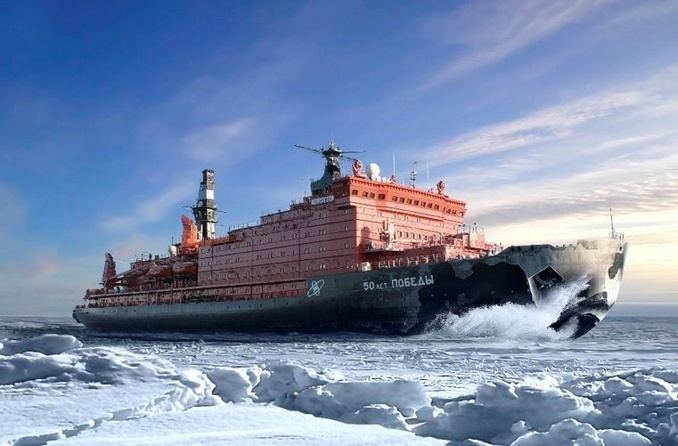
Construction on project no. 10521 started on October 4, 1989 at the Baltic Works in Leningrad (now Saint Petersburg), USSR. Originally the ship was named NS Ural. Work was halted in 1994 for lack of funds, so that the actual fiftieth anniversary of Victory Day, in 1995, found the ship in an abandoned state. Construction was restarted in 2003.
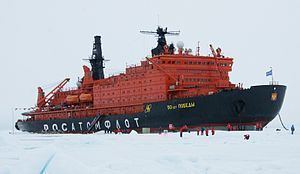
On 30 November 2004, a fire broke out on the ship. All workers aboard the vessel had to be evacuated while the fire crews battled the fire for some 20 hours before getting it under control; one worker was sent to the hospital.
She was finally completed in the beginning of 2007, after the 60th Anniversary. The icebreaker sailed into the Gulf of Finland for two weeks of sea trials on February 1, 2007.
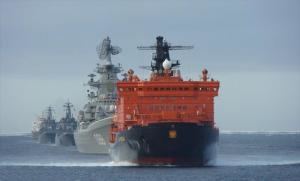
Upon completing sea trials, the icebreaker returned to St. Petersburg Baltic shipyard and started preparations for her maiden voyage to Murmansk. The new ship showed superior characteristics for an icebreaker, such as exceptional maneuverability and a top speed of 21.4 knots (39.6 km/h; 24.6 mph).
She arrived at her homeport Murmansk on April 11, 2007.
The icebreaker is an upgrade of the Arktika-class. The 159.60 m (524 ft) long and 30.0 m (98 ft) wide vessel, with a displacement of 25840 metric tons, is designed to break through ice up to 5 meters (16.4 feet) thick. She has a 140-man crew.
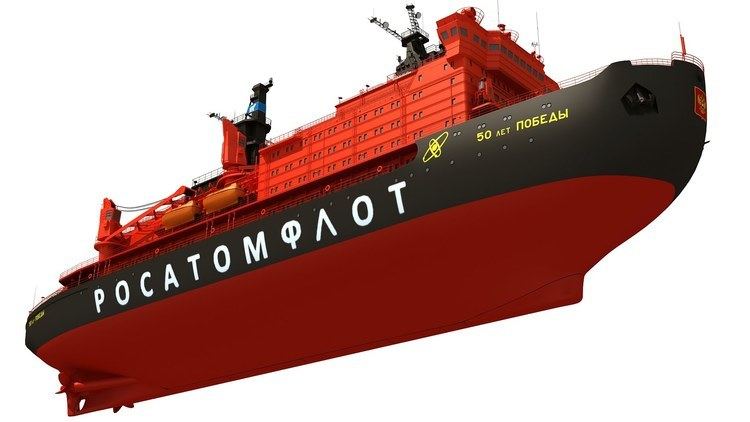
Fiftieth Anniversary of Victory is also an experimental project; for the first time in the history of Russian icebreakers it used a spoon-shaped bow. As predicted by the ship's designers, such a shape increases the efficiency of the ship's efforts in breaking the ice. The icebreaker is equipped with an all-new digital automated control system. The biological shielding complex was heavily modernized and re-certified by the State Commission. A new ecological compartment was created.
The ship has an athletic/exercise facility, a swimming pool, a library, a restaurant, a massage facility, and a music salon at the crew's disposal.
A group of eclipse chasers have used the vessel to observe the eclipse of August 1, 2008. They departed from Murmansk on July 21, 2008 and reached the North Pole on July 25, 2008, which sets a speed record for the ship (the trip lasted 4 days instead of 7).
50 let pobedy leaving oden in the pack ice
Arctic tourism
Since 1989 the nuclear-powered icebreakers have also been used for tourist purposes carrying passengers to the North Pole. Each participant pays up to US $25,000 for a cruise lasting three weeks. The Fiftieth Anniversary of Victory contains an accommodation deck customised for tourists.
Quark Expeditions chartered the ship (which they name as 50 Years of Victory) for expeditions to the North Pole in 2008. The vessel's maiden voyage to the North Pole embarked in Murmansk, on June 24, 2008. The ship carried 128 guests in 64 cabins in five categories. 50 Years of Victory completed a total of three expeditions to the North Pole in 2008 for the polar adventure company.
As of February, 2013, Quark Expeditions was listing the 50 Years of Victory in the company fleet and offering it for a North Pole cruise as well as Russian cruise company Poseidon Expeditions.
On July 30, 2013 50 Years of Victory reached the North Pole for the 100th time in the history of icebreaker navigation during one of Poseidon Expeditions cruises.
In October 2013, it carried the Olympic Flame to the North Pole, in the runup to the 2014 Winter Olympics
